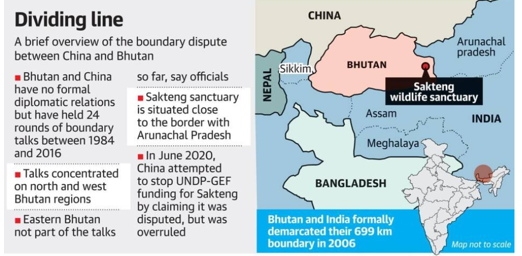

China makes a new claim on the eastern border with Bhutan and reiterates it has a border dispute with Bhutan in the eastern sector.
Context
China makes a new claim on the eastern border with Bhutan and reiterates it has a border dispute with Bhutan in the eastern sector.
What’s behind China’s expansion of its territorial dispute with Bhutan?
- The Sino-Bhutanese relationship normally flies under the radar. Bhutan has the distinction of being the only other country apart from India with which China has an unsettled land border.
- It is also the only state to border China that does not have official diplomatic ties with Beijing. But despite this lack of official relations, the two sides have worked for years to arrive at a resolution to their border disputes, which until now primarily focused on areas in the central and western sectors.
- The western sector dispute — over the Doklam plateau — has received the most attention after the 2017 India-China standoff there. The central sector disputes — over areas known as Jakarlung and Pasamlung — have received less attention comparatively.
- Even without formal diplomatic ties, Bhutan and China have held 24 rounds of border talks between their envoys; talks that have been frozen since their last round in 2016, partly due to the heightened tensions that erupted during the Doklam standoff. A 25th round is yet to take place.
Eastern sector claim:
- The addition of the eastern sector is notable as this has not been part of the agenda across the 24 rounds of China-Bhutan border talks. The China’s MFA statement’s inclusion of the eastern sector came shortly after the government of Bhutan issued a demarche to China after a Chinese delegate at the 58th Global Environment Facility Council, held earlier this summer, referred to the Sakteng Wildlife Sanctuary, an area in eastern Bhutan, as disputed.
- The claim itself may have some basis in history, but not one well supported by official Chinese maps. Back in 2017, in the course of studying the Sino-Indian and Sino-Bhutanese disputes over Doklam, it came across at least one older, unofficial Chinese map that portrayed a capacious dispute in the eastern sector.
- Now, that view has changed in Beijing. The political geography of the area in question bears underscoring: Given that India fully administers Arunachal Pradesh, even if Bhutan were to unilaterally cede this area, it would amount to an enclave without any direct border with China’s Tibet Autonomous Region.
The complicating factors:
- The novelty of China’s claim in its dispute with Bhutan has already raised eyebrows, but there are other complicating factors here.
- First, the purported eastern sector dispute over the Sakteng Wildlife Sanctuary, in geographic terms, would be the single largest tranche of disputed territory across all sectors in the China-Bhutan context, representing about 11 percent of the territory currently administered by the Bhutanese government.
- Second, the territory in question abuts the Indian state of Arunachal Pradesh, which is itself claimed in its near entirety as part of Tibet.
- Not only is this the case, but the Sakteng area specifically borders Arunachal’s western Tawang region, which China has particularly prioritized in negotiations with India; arguably, Tawang is the least negotiable piece of territory for Beijing in the entirety of the eastern sector.
Background of Border issues between Bhutan and China
- Early Chinese territorial claims on Bhutan: Chinese claims on Bhutanese territory were first made when Mao Zedong declared in the original 1939 version of The Chinese Revolution and the Communist Party that "the correct boundaries of China would include Burma, Bhutan, and Nepal".
- The annexation of Bhutanese enclaves: In July 1959, along with the occupation of Tibet, the Chinese People's Liberation Army occupied several Bhutanese enclaves in western Tibet which were under Bhutanese administration for more than 300 years and had been given to Bhutan by a Ladakhi King Singye Namgyal in the 17th
- Chinese map claiming territories in Bhutan: A Chinese map published in 1961 showed China claiming territories in Bhutan, Nepal, and the Kingdom of Sikkim. Incursions by Chinese soldiers and Tibetan herdsmen also provoked tensions in Bhutan. Imposing a cross-border trade embargo and closing the border, Bhutan established extensive military ties with India.
- Engagement: Until the 1970s, India represented Bhutan's concerns in talks with China over the broader Sino-Indian border conflicts. Obtaining membership in the United Nations in 1971, Bhutan began to take a more independent course in its foreign policy. In 1984, China and Bhutan began annual, direct talks over the border dispute. However, China's building of roads on what Bhutan asserts to be Bhutanese territory, allegedly in violation of the 1998 agreement, has provoked tensions.
- On 11 August 2016 Bhutan Foreign Minister Damcho Dorji visited Beijing, capital of China, for the 24th round of boundary talks with Chinese Vice President Li Yuanchao. Both sides made comments to show their readiness to strengthen co-operations in various fields and hope of settling the boundary issues.
- Doklam crisis, 2017: When China started constructing a road in the disputed area of Doklam, Bhutan asked for help from India and it sent the army to stop the construction. The military standoff in the area lasted more than two months. However, after diplomatic conversations between the two sides, both countries agreed to withdraw troops from the region.
- Sakteng Wildlife Sanctuary: China raised a new dispute over territory in June 2020 that has never come up in boundary talks earlier. Beijing objected to the grant for Sakteng Wildlife Sanctuary (SWS) in eastern Bhutan’s Trashigang district bordering India and China, claiming that the location was disputed, during the virtual meeting of the Global Environment Facility (GEF) in the first week of June.
Conclusion:
Given the ongoing Sino-Indian tensions in the western sector of their border in Ladakh, the timing of the revelation of this “new” dispute with Bhutan will likely be seen as coercive by India.



